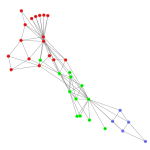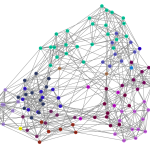Poster: Tapia 2016
Today our poster was accepted at the ACM Richard Tapia Celebration of Diversity in Computing in September 2016! Feedback from the reviewers was: Have more or clearer visualizations of the output communities Justify the metrics (conductance, etc.) and algorithms (Louvain, CNM) that…
Talk: Southern California Celebration of Women in Computing
We just got accepted to CWIC-SoCal 2016 to talk about our research! The presentation format will be a 12-minute talk followed by a 3-minute discussion, and will occur on Saturday, April 9. Feedback from the reviewers was very helpful, and…

Update on Testing Direction
We are currently focused on testing our modified algorithms on networks that have ground truths. In this way, we can compare the quality of the algorithms’ clustering outputs against the ground truth, and objectively determine which algorithms performed better in…
Increasing Java Heap Size
While testing our modified algorithms on larger graphs, we ran into a Java heap size error. The heap size is the amount of memory allocated to the program being executed. Because our current implementation of the Louvain algorithm is in Java…
Poster Proposals
We recently submitted our research to the Tapia conference and to the Southern California Celebration of Women in Computing conference! Here are our proposals: Tapia Poster Proposal SoCal CWIC Talk Proposal

Clusterings on Football Graph
We’ve begun testing Louvain-silhouette and Louvain-performance on a test suite of thirty-six networks from the Stanford Large Network Dataset Collection and The University of Florida Sparse Matrix Collection. One of our initial tests was on the football graph, which models American…
[Update 2] Louvain-Performance and Self-Loops
Since I decided not to modify the performance metric to account for self-loops, we are left with a Louvain-performance algorithm that always arrives at a very unhelpful “best” clustering: put all of the nodes in the same community. Luckily, the nature…
[Update 1] Louvain-Performance and Self-Loops
For background, please see my earlier post. Recall that we sometimes want the presence of self-loops to be stronger than inter-community links. That is, despite the weight of some inter-community edge (e_1, e_2), the presence of heavy self-loops (e_1, e_1) and (e_2,…

Louvain-Performance and Self-Loops
In phase 2 of each pass, the Louvain algorithm creates a collapsed version G’ of the current clustering G. Nodes in a community C in G are represented as a single vertex V_c in G’. Information about the weights of…
[Update 1] Louvain-Performance: Weights of Nonexistent Edges
Earlier, I wrote a post on how performance on weighted graphs uses a meaningful maximum M to account for the weights of nonexistent edges. At that time, my challenges were (1) figuring out how to calculate M, and (2) changing my…